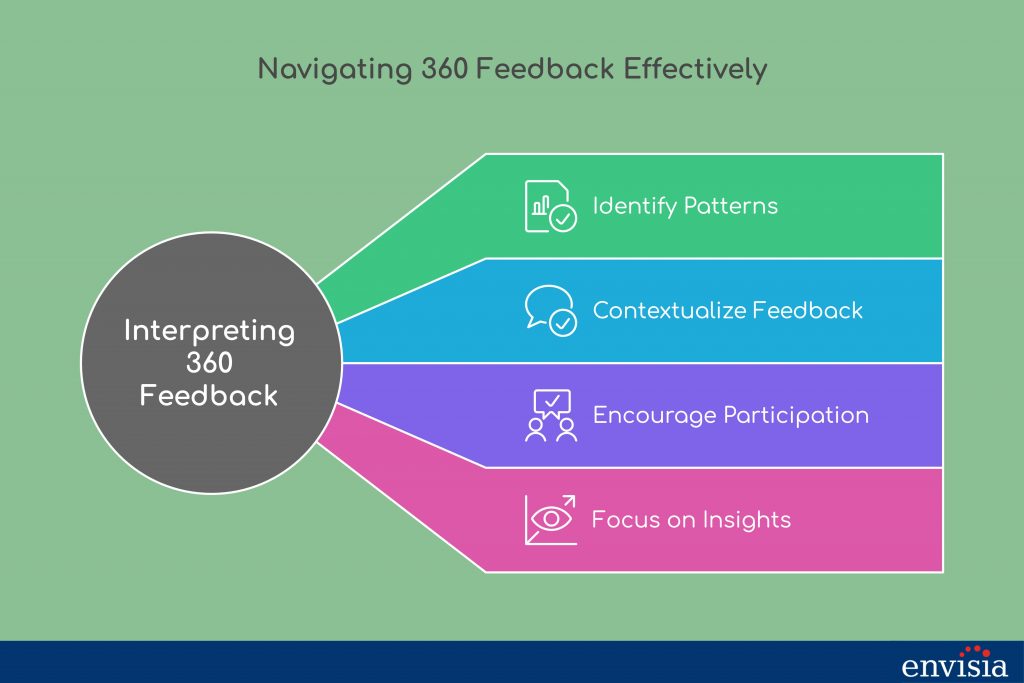Making Sense of Conflicting 360 Feedback
Employees often struggle with mixed messages when organizations implement 360-degree feedback as a performance management tool. A common challenge is determining whose feedback should guide development when discrepancies arise between rater groups—direct reports, peers, and supervisors. Understanding these differences is key to unlocking actionable insights that enhance employee performance and drive career development.

The Science Behind Rater Perspectives
Research highlights a critical insight: self-ratings in 360-degree feedback assessments rarely align with external perceptions. Different rater groups emphasize distinct factors:
- Direct reports focus on interpersonal dynamics and leadership approach.
- Supervisors emphasize employee performance, goal achievement, and competency.
- Peers often provide valuable insight into promotion potential.
These perspectives create a balanced view of an employee’s strengths and weaknesses, but conflicting rater feedback can make it difficult to identify areas for improvement. Research suggests that multi-rater feedback ambiguity can increase stress, particularly for individuals sensitive to negative feedback.
Navigating Conflicting Feedback
Employees often receive 360 degree feedback results with contrasting viewpoints. For example, direct reports may highlight strong interpersonal skills, while a supervisor may perceive a lack of strategic focus. These discrepancies can create uncertainty about areas for improvement.
To address conflicting perspectives, employees can benefit from analyzing feedback themes, engaging in constructive feedback discussions, and developing targeted action plans. Understanding differences in rater perspectives can improve leadership presence and ensure alignment with organizational expectations. Feedback from many sources provides a well-rounded view of strengths and areas for growth.
Best Practices for Interpreting 360 Feedback
1. Identify Patterns, Not Outliers
Look for trends across multiple sources rather than isolated comments. If both peers and direct reports highlight weak delegation skills, that’s a priority.
2. Contextualize Feedback Results
Different rater groups have different priorities. A supervisor’s emphasis on productivity may align with organizational performance, while peer feedback highlights teamwork. Context is key to accurate interpretation.
3. Encourage Open and Honest Participation
Ensuring employees believe their responses remain confidential promotes candid feedback and reduces fear of retribution. A strong feedback system fosters trust.
4. Focus on Actionable Insights
Use feedback to set clear learning and development goals. For example, if team members highlight weak communication, seek coaching or training.

The Pros and Cons of 360-Degree Feedback
While 360-degree feedback systems offer a collective feedback process to evaluate an employee’s performance, there are challenges to consider. For a deeper look into the pros and cons of 360-degree feedback, check out this detailed analysis.
Pros:
- Provides a fuller picture of an employee’s performance across different levels.
- Encourages growth and development through constructive feedback.
- Enhances traditional performance appraisal by incorporating diverse insights.
Cons:
- A small number of raters may lead to biased or vague responses.
- Without training, participants may misinterpret feedback assessment results.
- Overemphasis on performance rating can overshadow personal development goals.
Implementing 360-Degree Feedback in Organizational Strategy
For human resources leaders, effectively implementing 360-degree feedback requires integration with performance management frameworks. Tools like Envisia Learning’s NeuroTeamView support organizations by offering real-time insights and recommendations to enhance employee engagement.
Pairing 360 degree feedback with StressScan assessments can help uncover stress-related barriers, ensuring a holistic approach to employees’ career growth. Additionally, providing feedback in real-time allows teams on the ground to adjust behaviors swiftly and super-charge conversion rates.
Addressing Leadership Gaps with 360 Feedback
Organizations use 360-degree feedback processes to identify leadership blind spots. In some cases, direct reports may praise a manager’s accessibility, while supervisors highlight concerns about missed deadlines. Translating feedback results into actionable coaching plans can improve leadership effectiveness. Structured development efforts often result in measurable productivity improvements, reinforcing the value of a successful 360 feedback program.
The Role of Technology in 360 Feedback
Modern feedback mechanisms like Envisia’s 360 Degree Feedback platform streamline the feedback assessment process, offering digital self-service tools. Features such as pricing studies and real-time tracking help organizations run concept tests before full-scale implementation, ensuring they get faster and more effective results.

Conclusion: Embrace the Complexity of Feedback
360-degree feedback isn’t about deciding whose input matters most—it’s about synthesizing diverse perspectives to fuel growth and development. Whether discrepancies stem from rater biases or genuine behavioral shifts, each insight contributes to enhancing employee performance.
For organizations looking to optimize their performance evaluation process, a well-structured 360-degree feedback program is key. By balancing candid feedback with strategic alignment, companies can create a performance management tool that strengthens leadership and increases revenue and loyalty across the organization.
